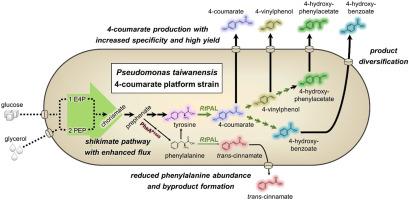Metabolic Engineering ( IF 6.8 ) Pub Date : 2023-05-18 , DOI: 10.1016/j.ymben.2023.05.004 Benedikt Wynands 1 , Franziska Kofler 1 , Anka Sieberichs 1 , Nadine da Silva 1 , Nick Wierckx 1

|
Aromatics are valuable bulk or fine chemicals with a myriad of important applications. Currently, their vast majority is produced from petroleum associated with many negative aspects. The bio-based synthesis of aromatics contributes to the much-required shift towards a sustainable economy. To this end, microbial whole-cell catalysis is a promising strategy allowing the valorization of abundant feedstocks derived from biomass to yield de novo-synthesized aromatics.
Here, we engineered tyrosine-overproducing derivatives of the streamlined chassis strain Pseudomonas taiwanensis GRC3 for efficient and specific production of 4-coumarate and derived aromatics. This required pathway optimization to avoid the accumulation of tyrosine or trans-cinnamate as byproducts. Although application of tyrosine-specific ammonia-lyases prevented the formation of trans-cinnamate, they did not completely convert tyrosine to 4-coumarate, thereby displaying a significant bottleneck. The use of a fast but unspecific phenylalanine/tyrosine ammonia-lyase from Rhodosporidium toruloides (RtPAL) alleviated this bottleneck, but caused phenylalanine conversion to trans-cinnamate. This byproduct formation was greatly reduced through the reverse engineering of a point mutation in prephenate dehydratase domain-encoding pheA. This upstream pathway engineering enabled efficient 4-coumarate production with a specificity of >95% despite using an unspecific ammonia-lyase, without creating an auxotrophy. In shake flask batch cultivations, 4-coumarate yields of up to 21.5% (Cmol/Cmol) from glucose and 32.4% (Cmol/Cmol) from glycerol were achieved. Additionally, the product spectrum was diversified by extending the 4-coumarate biosynthetic pathway to enable the production of 4-vinylphenol, 4-hydroxyphenylacetate, and 4-hydroxybenzoate with yields of 32.0, 23.0, and 34.8% (Cmol/Cmol) from glycerol, respectively.





















































 京公网安备 11010802027423号
京公网安备 11010802027423号